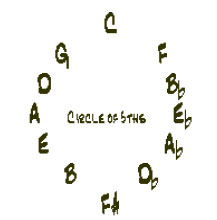« The ii-V-I chord progression |
Main
| Flatwound for octave mandolin and mandola »
 December 9, 2010 | Jazz Primer: Harmonic Function December 9, 2010 | Jazz Primer: Harmonic Function
Last week, Don Julin introduced us to the concept of the 'ii V I' chord. Let's step back and review this cadence within the context of harmonic function. Some of the following material is in deeper detail in the Getting into Jazz Mandolin book, but this article can be a useful summary introduction. We'll review some of the vocabulary music theorists, especially jazz musicians banter about. This should help you understand what they are talking about, and more importantly, but the symbols within the context of "function."

Basic notation conventions to help you understand:
Roman Numerals used in Scale Degrees (I through VII)
Upper Case designate Major chord; I, II, III, IV, V, VI, VII
Lower Case designate Minor chord; i, ii, iii, iv, v (theoretical), vi, vii
Seven three-note chords (triads) based on scale degrees:
Major: I ii iii IV V vi viiº I
Minor: i iib5 III iv V VI viiº i
Example Key of A:
Major: A Bm C#m D E F#m G#dim A
Minor (Harmonic): Am Bdim C Dm E F G#dim
(Note: no Alpha-numeric suffix implies major)
Key of A, diatonic 7th chords:
Major: AMaj7 Bm7 C#m7 DMaj7 E7 F#m7 G#m7b5 AMaj7
Minor (Harmonic): Am7 Bm7b5 CMaj7 Dm7 E7 FMaj7 G#m7b5
This introduces us to the concept of Tonic and Dominant Function. The I chord is your Tonic, the V (V7) is your Dominant. Try playing through the following familiar chords, and use your ears to hear how they progress into each other:
E to A (E7 to A)
A to D (A7 to D)
G to C (G7 to C)
B to E (B7 to E)
These are all Dominant chords proceeding to Tonic chords. The second of the pair is the Tonic or home key. Let's also point out here that your key signature can help you in establishing the basic home key, but in jazz, you are not limited to one key. In most cases, you will flow through anywhere from 2 to 6 different keys or "tonal centers" in one song, so it's important to not necessarily think in terms of key signatures.

Dominant Alternative:
Notice the voicing of the triad in the 7th degree of the A Major scale, compared to the V7 chord:
viidim = G# B D (G#dim)
V7 = E G# B D (E7)
They are identical, except for the E. This points out a strong alternative for the V, by merely dropping the root of the chord. The V is a fairly benign tone anyway, except when it's used in the bass, so you can use the diminished vii and V7 (or vii7b5 and V9) interchangeably.
Dominant Preparation:
This concept allows a little more "liberty" in interpretation. Chords may set up or prepare the Dominant which ultimately resolves to a Tonic. While the Dominant is more limiting and arbitrary, the choices in chords that prepare for the Dominant are more abundant.
In A Major, the chords could be Bm (Bm7), D (DMaj7), or chords like C#m and F#m, all of which are chords based on the diatonic scale. Preceding or preparing for the Dominant to Tonic "statement" possibilities would be:
Bm E A
Bm7 E7 AMaj7
F#m7 E7 AMaj7
F#m7 Bm7 E7 AMaj6 (two preparation chords)
Notice it's the last two chords that define the key center aurally. No matter what you do to prepare, it's that E7 to A that really brings us home.
'ii V7 I' Cadence
Now we have the most common jazz "sentence." Take a listen to Bm7 E7 A, and you have all three ingredients, the Dominant Preparation, Dominant, and Tonic, in about as succinct a progression as you can make. State it, then get out of the way and listen. You ought to be able to clearly sing back the I or tonic, even without knowing what notes you just played. It's where the rubber meets the road.
Understand that working in this context allows you to freely define tonal centers and use the appropriate scales to base your improvisation on. Once you identify within the song where these tonal centers of Prep, Dominant, and Tonic are, you can implement the full diatonic scale of the progression.
Hybrid
Hybrid chords are relatively new, and we don't need to explore them too much other than to say sometimes the function can be blurred. In the case of suspended or (Sus4) chords, they can be categorized as both Preparation and Dominant.
Further:
The ii-V-I chord progression
Middle ground; reading jazz fake books
Numbers.
'ii V7 I' Home Positions
Secondary Dominants
Posted by Ted at December 9, 2010 7:02 AM

Disclaimer: In the 'Information Age' of the 21st Century,
any fool with a computer, a modem, and an idea can
become a self-professed 'expert." This site does not
come equipped with 'discernment.'
|



